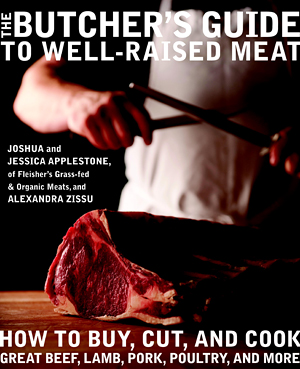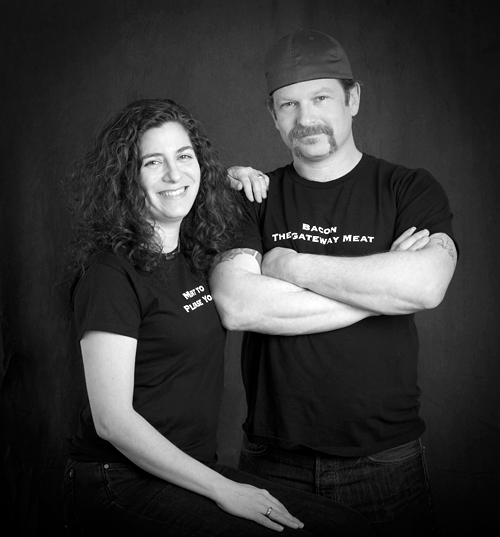 Jessica and Joshua Applestone's story is, by now, a familiar one. Vegetarian/vegan couple gets interested in sustainability, organics, and the implications of ethical eating. They start reading and going to farms and farmers' markets, realize that the staff (and signage) at most big food retailers--even the ones that tout their eco-friendliness--are uninformed and unreliable. Who to believe? How to make a difference? What to make for dinner?
Jessica and Joshua Applestone's story is, by now, a familiar one. Vegetarian/vegan couple gets interested in sustainability, organics, and the implications of ethical eating. They start reading and going to farms and farmers' markets, realize that the staff (and signage) at most big food retailers--even the ones that tout their eco-friendliness--are uninformed and unreliable. Who to believe? How to make a difference? What to make for dinner?
This is where the Applestones' story veers off from the typical hipster vegan-turned-ethical omnivore trajectory. They didn't just find a meat CSA and fill their freezer with grass-fed hangar steak and pork belly destined for homemade ramen or home-cured bacon. That's what might happen now, in 2011, here in San Francisco. But this was 2004, only a couple of years after Eric Schlosser's Fast Food Nation had been published. Michael Pollan's New York Times Magazine article, Power Steer, which followed the short, unhappy life of one young, burger-destined steer in a Kansas feedlot, had just made millions of beef-eating Americans realize that most of the corn- and soy-stuffed animals they were buying had never come near a blade of grass. Grass-fed meat, what little there was of it, was hard to find, and usually available only shipped frozen from the Midwest. So what did they do? They started a butcher shop in New York's Hudson Valley selling only pasture-raised meats, a butcher shop that bought only whole animals from small farmers and ranchers they knew. Joshua, still vegan at the time they started the business, learned the butchery side, a trade plied by both his grandfather and great-grandfather. They called the shop Fleisher's Grass-Fed Organic Meats, from Joshua's family name. They got advice from dozens of retired butchers, almost all of whom told them that they were crazy, that they'd be out of business and worse, divorced, in a matter of months.
Now, some 7 years later, their business (and their marriage) is not just intact, but thriving. This fall, they're opening their second shop, in Brooklyn's Park Slope neighborhood, with a third one planned for the Upper West Side. (Take that, Zabar's!) The food culture has caught up with them, and "grass-fed" and "pasture-raised" have entered the common dialogue of more than just a few provenance-obsessed food folks. This week, Joshua and Jessica made the trek West for a series of events promoting their new book, The Butcher's Guide to Well-Raised Meat: How to Buy, Cut, and Cook Great Beef, Lamb, Pork, Poultry, and More. I caught up with them at an after-party at Bernal Heights butcher shop Avedano's, following their book-signing at nearby Omnivore Books and their on-air appearance on KQED's Forum with Avedano's butcher and co-owner Tia Harrison. (Harrison is also the chef at Sociale and a co-founder of the Butchers' Guild.)
Like a lot of New Yorkers, Jessica has a San Francisco connection; while she was raised in Long Island, her father grew up here, and she lived in the city from 1989-1991, working at the San Francisco Bay Guardian and Mercury Press before moving to Tokyo and New York City. "I miss the real foodie culture here, the diversity of ethnicities. And the Mexican food!" she said as we stood near a candlelit platter of ham. She and her husband have dubbed Kingston, NY, where they have their shop, "Park Slope North" for the number of Brooklynites from that Berkeley-ish neighborhood who spend their weekends up in their locale. Woodstock (yes, that Woodstock) is close by, as is New Paltz, a busy college town whose young mayor made headlines in 2004 for issuing marriage licenses and performing civic weddings for 25 same-sex couples, six years before gay marriage was legalized in New York. Without customers from these bourgeois-bohemian enclaves, she admits, much of their painstakingly sourced, meticulously cut meat wouldn't get bought, week after week. Although their learning curve was steep (says Jessica, "We didn't have a learning curve; it just went straight up from the minute we started"), their butcher shop has become, amazingly, something almost exactly what they envisioned: a source not just of meat but of community, a place where the butchers know their customers by name, and where people chat and ask questions, take classes, share recipes and swap neighborhood gossip, and in the process, use their food dollars to support a whole network of local farmers, ranchers, slaughterhouses, and more.
Their book is an unintimidating, user-friendly guide for the home cook, one who's curious about this whole whole-beast thing but doesn't yet have the chops, or the knowledge, to get busy with a boning knife. It's a primer on primals, the "big cuts" that well-trained butchers break down into the more familiar chops, ribs, sirloins and roasts. This is no encyclopedia of meats; the type is big, there are lots of chatty sidebars and plenty of weekday-dinner recipes. Even if you never follow their instructions for butterflying a leg of lamb or frenching a crown roast, you can still learn a lot of useful basics to make you feel much more at home in front of a meat case. Particularly useful are the pages championing their favorite lesser-known butcher's cuts, like lamb sirloin (one of my favorites, and frequently on hand at Avedano's), the cuts that a butcher knows but rarely sells.
